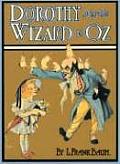The Darkness of Dorothy and the Wizard in Oz
Eric Shanower and Skottie Young have reached Dorothy and the Wizard in Oz, the fourth title, in their adaptation of L. Frank Baum’s Oz novels for Marvel Comics. When Newsarama interviewed the team, Shanower spoke to the book’s “darkness”:
In his previous two Oz books, Baum had played down such talk; variations on the words “die” and “kill” appear only 13 times altogether in Ozma of Oz, for example. His young heroes in those books worry about being turned into statuary, not about being killed.
On the other hand, death hovers over the action in The Wonderful Wizard of Oz. During that adventure, Dorothy and her companions end up killing two witches, two Kalidahs, a wildcat, forty wolves, forty crows, and a giant spider, plus uncounted bees. And the book uses the word “kill” 34 times. So one could argue that Dorothy and the Wizard of Oz was really a return to form.
The villains introduced in Dorothy and the Wizard in Oz are among Baum’s scariest. The Mangaboos, the underground vegetable people, are just creepy. The man-eating invisible bears are terrifying because you can’t tell whether one’s standing next to you ready to slash your guts out at any moment. The silent wooden Gargoyles are so alien—I can’t wait to see how Skottie draws them. . . .In an essay published in The Baum Bugle on the centenary of this book, I called Dorothy and the Wizard “one of Baum’s most breathlessly exciting fairy tales”:
To say that Dorothy and the Wizard in Oz is one of the darkest Oz books is no joke. The characters are in danger of imminent death in nearly every chapter. Baum’s evocation of the underground caverns they’re trapped in is oppressive. It’s weird and creepy, and those are reasons I love this book.
The middle chapters, starting when the Mangaboos stuff the party into the Black Pit, resemble nothing so much as an action-filled videogame. Dorothy, the Wizard, and their friends run, jump, stab, and shoot their way up from one level to the next. Enemies become more formidable, the path harder to climb.That essay also tabulated how often Dorothy and the Wizard uses forms of the words “die” and “kill”: 36 times. As early as chapter 2, during the earthquake, Baum tells us that young Dorothy and Zeb felt “the natural fear that sudden death was about to overtake them at any moment.” Chapter 4 ends with the Mangaboo prince saying, “Follow me, please, to meet your doom”—a powerful cliffhanger, but poor bedtime reading for small children. After being captured by the Gargoyles, Dorothy and her friends “expected nothing less than instant death.”
In his previous two Oz books, Baum had played down such talk; variations on the words “die” and “kill” appear only 13 times altogether in Ozma of Oz, for example. His young heroes in those books worry about being turned into statuary, not about being killed.
On the other hand, death hovers over the action in The Wonderful Wizard of Oz. During that adventure, Dorothy and her companions end up killing two witches, two Kalidahs, a wildcat, forty wolves, forty crows, and a giant spider, plus uncounted bees. And the book uses the word “kill” 34 times. So one could argue that Dorothy and the Wizard of Oz was really a return to form.



No comments:
Post a Comment